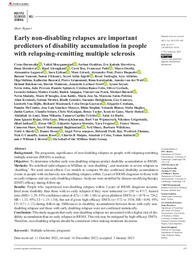Por favor, use este identificador para citar o enlazar este ítem:
https://hdl.handle.net/11000/37414Registro completo de metadatos
| Campo DC | Valor | Lengua/Idioma |
|---|---|---|
| dc.contributor.author | Daruwalla, Cyrus | - |
| dc.contributor.author | Sahygannejad, Vahid | - |
| dc.contributor.author | Ozakbas, Serkan | - |
| dc.contributor.author | Kubala Havrdova, Eva | - |
| dc.contributor.author | Horakova, Dana | - |
| dc.contributor.author | Alroughani, Raed | - |
| dc.contributor.author | Cavit Boz, Francesco Patti | - |
| dc.contributor.author | Onofrj, Marco | - |
| dc.contributor.author | Lugaresi, Alesssandra | - |
| dc.contributor.author | Eichau, Sara | - |
| dc.contributor.author | Girard, Marc | - |
| dc.contributor.author | Prat, Alexandre | - |
| dc.contributor.author | Duquette, Pierre | - |
| dc.contributor.author | Yamout, Bassem | - |
| dc.contributor.author | Khoury, Samia J | - |
| dc.contributor.other | Departamentos de la UMH::Medicina Clínica | es_ES |
| dc.date.accessioned | 2025-09-15T13:11:00Z | - |
| dc.date.available | 2025-09-15T13:11:00Z | - |
| dc.date.created | 2023-06 | - |
| dc.identifier.citation | Mult Scler . 2023 Jun;29(7):875-883 | es_ES |
| dc.identifier.issn | 1477-0970 | - |
| dc.identifier.uri | https://hdl.handle.net/11000/37414 | - |
| dc.description.abstract | Background: The prognostic significance of non-disabling relapses in people with relapsing-remitting multiple sclerosis (RRMS) is unclear. Objective: To determine whether early non-disabling relapses predict disability accumulation in RRMS. Methods: We redefined mild relapses in MSBase as ‘non-disabling’, and moderate or severe relapses as ‘disabling’. We used mixed-effects Cox models to compare 90-day confirmed disability accumulation events in people with exclusively non-disabling relapses within 2years of RRMS diagnosis to those with no early relapses; and any early disabling relapses. Analyses were stratified by disease-modifying therapy (DMT) efficacy during follow-up. Results: People who experienced non-disabling relapses within 2 years of RRMS diagnosis accumulated more disability than those with no early relapses if they were untreated (n=285 vs 4717; hazard ratio (HR)=1.29, 95% confidence interval (CI)=1.00–1.68) or given platform DMTs (n=1074 vs 7262; HR=1.33, 95% CI=1.15–1.54), but not if given high-efficacy DMTs (n=572 vs 3534; HR=0.90, 95% CI=0.71–1.13) during follow-up. Differences in disability accumulation between those with early nondisabling relapses and those with early disabling relapses were not confirmed statistically. Conclusion: This study suggests that early non-disabling relapses are associated with a higher risk of disability accumulation than no early relapses in RRMS. This risk may be mitigated by high-efficacy DMTs. Therefore, non-disabling relapses should be considered when making treatment decisions. | es_ES |
| dc.format | application/pdf | es_ES |
| dc.format.extent | 9 | es_ES |
| dc.language.iso | eng | es_ES |
| dc.publisher | Sage Journals | es_ES |
| dc.rights | info:eu-repo/semantics/openAccess | es_ES |
| dc.rights.uri | http://creativecommons.org/licenses/by-nc-nd/4.0/ | * |
| dc.subject | multiple sclerosis | es_ES |
| dc.subject | prognosis | es_ES |
| dc.title | Early non-disabling relapses are important predictors of disability accumulation in people with relapsing-remitting multiple sclerosis | es_ES |
| dc.type | info:eu-repo/semantics/article | es_ES |
| dc.relation.publisherversion | 10.1177/13524585231151951 | es_ES |

Ver/Abrir:
Early non-disabling relapses are important.pdf
3,01 MB
Adobe PDF
Compartir:
 La licencia se describe como: Atribución-NonComercial-NoDerivada 4.0 Internacional.
La licencia se describe como: Atribución-NonComercial-NoDerivada 4.0 Internacional.
.png)